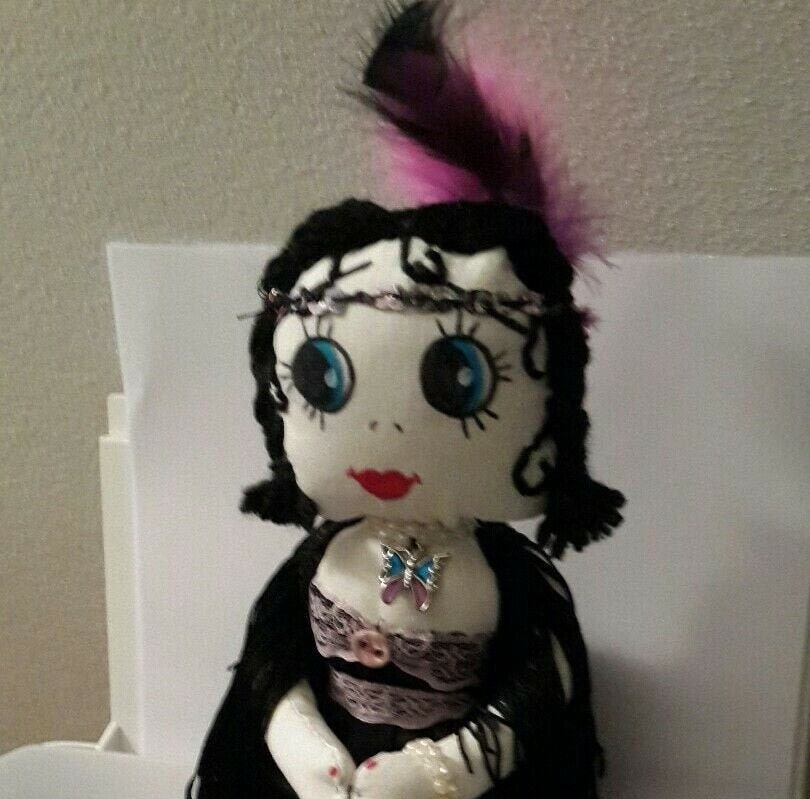

I came to learn that these were the actual prints that we had seen, years before, on TV. It seemed that no one was buying them, but me. That was a lot of money, but, every now and then, I would purchase one or two of these, even though, I didn’t own a projector, yet. And, one day, cutting through Willoughby’s Camera Emporium to take a short cut from Macys to Gimbals, I discovered that they were selling used 16 mm movies, and they had some Betty Boop sound cartoons for $10 each. M oving forward several more years: Now, we are living in an apartment on 28th street. Over the course of a year, we saw almost all of them.
#Original betty boop doll tv#
One Betty Boop began the show, followed by a horrible made for TV travesty called “Powwow the Indian Boy”, after which there was another Betty Boop cartoon. Half an hour, every weekday, at lunch time, two Betty Boop Cartoons miraculously aired on NYC TV. O ur infant daughter, Samantha, played in a playpen beside us, often watching a small black and white TV. It was a humble way to, almost, make a living. All day, every day, we sat at a large table made from a 4’ X 8’ sheet of plywood on sawhorses, hand making music boxes and reproductions of nonexistent antiques. We were just beginning an enterprise called Boutique Fantastique. My wife, Eunice, and I were living and working in an illegal loft on 26th street in Manhattan. Like Dante, I had glimpsed my Beatrice, and we didn’t meet again for several years.į ast forward to 1963. And that was it, seven minutes I would never forget. And that innocence is what made her so appealing.

And, unlike my purely visual interest in other comic characters, in Betty’s case, I loved her warm infectious personality, and her incredible voice. And yet, in spite of these extreme excursions, beyond the borders of what was considered pretty, she was beautiful to me. Her head was grossly oversized, her body was less that petite, with minutely tiny hands and feet. She turned the stereotypes of beauty upside down. And, suddenly, here was Betty Boop, the offspring of Max Fleisher, who I later learned was often referred to as, “the Jewish Disney.” I loved the way she looked.

But the other Disney heroines who followed her, from the equine bobby soxers, who frolicked in Fantasia to Cinderella, and Sleeping Beauty, were as vacuous as beauty queens. Snow White was loveable and charming, appealingly innocent and irresistible. W here had she been hiding all my life? The world of Disney that I was raised on was relentlessly antiseptic, devoid of any hint of sexuality. Even though she was toned down and buttoned up, she spoke in that adorable voice, and radiated her innocently alluring sex appeal, and that was enough to steal my heart, and make me fall in love with her that night love at first sight. So there was very little of Betty in the movie, and yet, there was enough.
#Original betty boop doll movie#
Worse still, the movie featured Grampy, who always did his best to steal the show.
#Original betty boop doll full#
On top of that, the cartoon was full of the worst kind of racial stereotypes as was often the case, when comic characters, especially, Mickey Mouse, came face to face with cannibals, in the 1930s. T he cartoon that was shown that night was one of Betty’s worst, “Zulu Hula”, a late offering, created when her career was waning, as she was being forced into oblivion by overzealous censorship. And, so, it seemed utterly incredible that, in all those years, I had never seen or heard of Betty Boop. They were the source of inspiration that directed my destiny along the road to Disney, and beyond, to art school. Growing up in Detroit Michigan, Walt Disney and animated cartoon characters, in general, had been my nourishment, and my salvation. O ne night, a single Betty Boop cartoon was added to the evening’s program as an extra diversion. And it was there, at the Cinémathèque française that I first met, and fell in love with Betty Boop. Ten years later, Ken, who coined the phrase "Mouse Heaven" would become a family friend. It was there, too, that I first saw films by Kenneth Anger, “Eaux d'Artifice” and “Scorpio Rising”. I remember seeing Eisenstein’s Masterpieces, “Alexander Nevsky”, and “Ivan the Terrible”, with subtitles in French, as well as Salvador Dali's epics “Chien Andalou” and “L’Age d’Or”. W hen I was living in Paris, the Cinémathèque française was a cinema museum where my friends and I often went to see great movies, free.


 0 kommentar(er)
0 kommentar(er)
